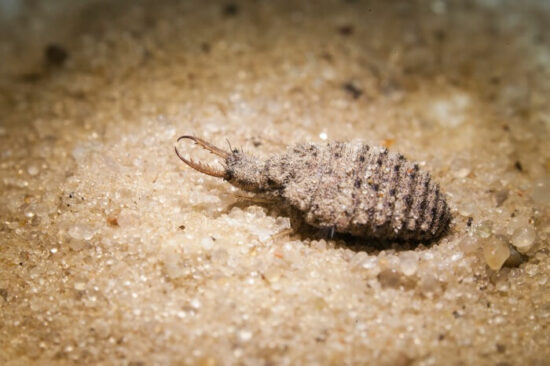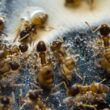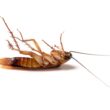When it comes to the list of what eats ants, there are a number of bugs and animals you can pick from. Since ants are found all over the world, they have plenty of natural predators!
Read on to find out everything you need to know about what eats ants.
Bugs That Eat Ants
Ants are some of the most resilient critters on the planet. While they’re small and virtually defenseless on their own, the sheer size of large colonies makes them a force to reckon with in the animal kingdom.
All that said, ants aren’t without formidable opponents! If you’re wondering what eats ants, the list is rather long. These insects are pretty low on the food chain and act as a source of sustenance for many living creatures. Relatively high in fat, protein, and vitamins, they’re a common food source for a wide range of insects.
Antlions
Antlions are a lesser-known insect species that exclusively feeds on ants. There are about 2,000 different types of antlions around the globe, so they’re pretty widespread. The reason you don’t see too many of them around is that they’re nocturnal.

Adults are sporting long cylindrical bodies and large wingspans. Powerful predators, adults have a healthy appetite for ants and arthropods.
While adults can eat ants unlucky enough to cross paths with them, the larvae are actually the most cunning. Antlion larvae, called doodlebugs, create deep pits in loose soil. When an ant falls in, the walls of the cavity prevent them from crawling back out.
The doodlebugs wait for unsuspecting ants at the bottom of the pit. They use their powerful jaws to continually eat ants until they’re ready to pupate into adults.
Butterflies
Believe it or not, delicate butterflies are bugs that eat ants as well. The species with the most extreme feeding habits are blue butterflies. Named for their stunning coloration, these insects are real eye-catchers.

But don’t let that fool you. The butterflies are clever and take advantage of ants in interesting ways.
Essentially, adult butterflies mask their larvae to mimic ant broods. They do this with both scent and sound. The mimicry is so convincing that entire ant colonies mistake the butterfly larvae as some of their own.
That’s not all. The scent is similar to that of a queen ant, so the ant colony gives it the royal treatment. They take good care of the larvae by feeding them ant grubs!
Once the larva develops more, it ends up eating large quantities of ants in the colony.
Spiders
These eight-legged insects are common natural predators of ants. Some will spin webs to catch ants and other insects. As ants struggle to free themselves from the sticky trap, the vibrations alert the spider to strike!
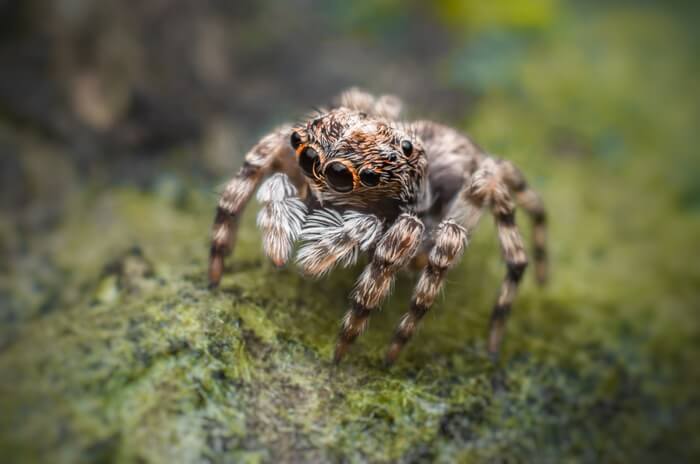
In a matter of seconds, the spider will wrap the ant and consume it!
Some species use a much simpler approach. Instead of going through the trouble to build a web, they simply lay low and wait for an ant to pass by. When they do, the spider will pounce for the kill!
The most common ant-eating species are jumping spiders, wolf spiders, black widow spiders, and lynx spiders. However, most spider species will eat an ant if given a chance. Even daddy long legs (which technically aren’t spiders) will scarf down ants all day long.
Bombardier Beetles
Featured on our list of what eats ants is the bombardier beetle. This is a unique insect with some impressive defensive skills. When threatened, the beetle will eject an acidic spray from their abdomen! The spray is so powerful that it makes an audible popping sound.
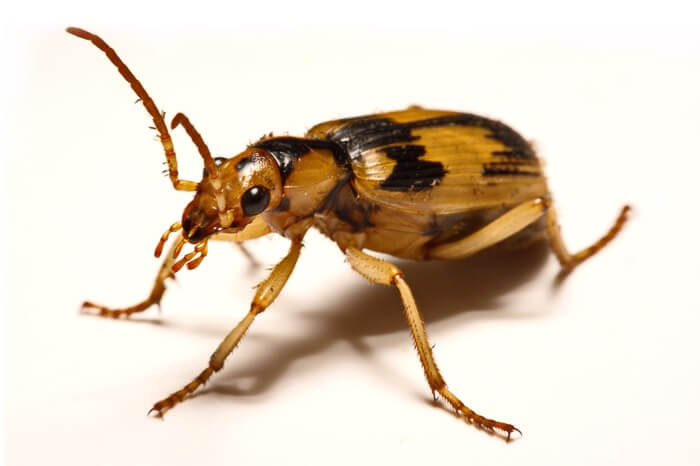
Interestingly enough, ants play a big part in creating that acid. They consume many insects, but ants are a significant portion of their diet. When these insects eat ants, they extract formic acid from their bodies to use as the defense spray.
Bombardier beetles frequently storm nests and colonies to eat ants. The tiny insects are no match for the beetle’s shear strength.
Eucharitid Wasps
Here’s another cunning insect that’s capable of tricking entire colonies. Once again, the larvae are the heavy hitters here.
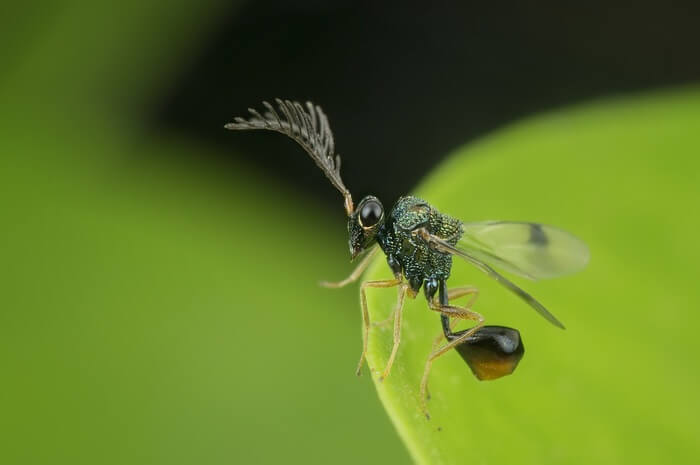
Adult Eucharitid wasps typically lay eggs on leaves or branches. Upon hatching, the larvae fall to the ground below and attach themselves to passing ants.
Because the wasp larvae take on a similar scent to ants, most don’t even notice! The young wasps get a free ride back to the ant colony. Once there, they make their way to the ant brood chamber and start eating.
The Eucharitid wasp larvae feed on the ant’s brood until they mature and pupate. At that point, they begin to kill and eat the adult ants.
Larva Mimic Flies
Larva mimic flies are invaders that like to storm ant colonies. Sometimes, the flies will only eat the food stores in the nest. However, some will also eat any ant that gets in their way.
Males of this species look like your typical fly. However, females don’t have any wings. They look like maggots and have girthy abdomens.
Both males and females enter ant colonies. That said, males are the only ones that migrate from one nest to another. They do so to mate with multiple females. Any ant that gets in the way acts as sustenance and fuel for mating.
Phorid Flies
Phorid flies look similar to fruit flies. They’re small and have a high arch in the thorax.
A significant natural predator of ants, phorid flies are sometimes used as intentional pest control! They will kill and eat a wide range of ant species. However, they’re particularly fond of fire ants.
How these flies eat ants is the stuff of nightmares!
The adult ants hover above colonies until they spot a healthy worker ant. Then, they swoop down and inject an egg-laying tube into a soft part of the ant’s exoskeleton. They deposit the eggs, and the ant continues with their day.
Once the larva hatches, it eats the ant’s head and destroys the brain. When this happens, the nymph essentially takes control of the dead ant’s body. It can force the ant to move to a safe space.
There, the ant will continue to eat the rest of the ant’s body and undergo metamorphosis.
Yikes.
Ant Nest Beetles
Also known as paussines, ant nest beetles are a product of extreme adaptation. These beetles use various techniques to trick ants and live freely among them.
An onslaught of chemical signals helps them blend in. Meanwhile, acoustic techniques effectively jam ant communication efforts. They use those methods to invade colonies, feed on broods, and use the underground networks for safety.
Paussines are pretty adaptable, allowing them to change strategies for different ant species.
Ant-Mugging Flies
This insect is appropriately named for its unique bullying behaviors.
It hovers around ants and waits for the right time to steal food from unsuspecting worker ants. The flies don’t just grab the food that the ant is carrying and move on. It forces them to regurgitate the items they already ate!
Ant-mugging flies grab onto the ant with their clamp-like antennae. Then, they imitate a signal to initiate vomiting.
If, for whatever reason, the ant doesn’t comply by throwing up its food to feed the fly, it’ll become a meal as well!
Different Kinds of Ants
There are thousands of different ant species in the world. Not all of them get along and coexist!
Many ant species are rivals and continually go to war. You can observe some surprisingly extreme behavior among battling colonies. They can enslave enemies, raid nests, show signs of aggression, and more.
Of course, one species can also eat another.
Fire ants are known to attack and eat other fire ants. Meanwhile, Army ants like to eat the brood of nearby ant nests. Raider ants will exclusively eat other ants. They invade colonies, forage for food, and eat the brood.
Some species, such as Solenopsis daguerrei ants, use parasitic behavior. Rather than starting her own colony, the queen invades other nests and takes the place of leaders she kills.
The ant kingdom is complex and full of aggression. It’s not uncommon to see somewhat cannibalistic behavior among them.
Other Animals That Eat Ants
It’s not just insects that eat ants. Other animals will also feed on these pests.
Animals tend to do the most damage to colonies, as they’re much larger and need to eat massive quantities of the insect to gain anything from the meal. Whether the ants are tasty snacks or a considerable part of their diet, there’s no shortage of animals that eat ants out there.
Here’s a list of the most common ones.
Birds
Several bird species are animals that eat ants. Those that feed on them frequently usually have long and thin beaks that can get into tight spots for easy capture.
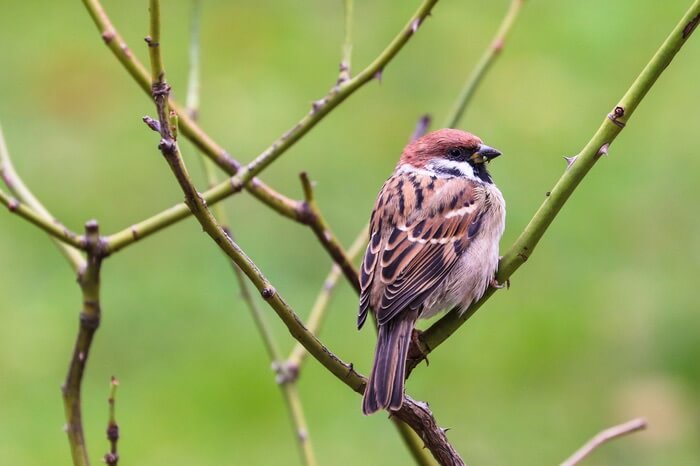
Some species even use ants for more practical means. Birds exhibit a behavior called “anting.” It’s when they rub dead ants on their body to ward off predators, address fungal problems, or fight disease.
The list of birds that eat ants is massive! The ones that are more likely to snack on ants frequently are:
- Sparrows
- Antbirds
- Hummingbirds
- Flickers
- Antpittas
- Downy Woodpeckers
- Starlings
- Wild Turkeys
- Grouses
Lizards
Lizards have a healthy appetite for ants as well. Most species prefer to consume more substantial insects like crickets and roaches. However, ants offer an accessible alternative that’s high in protein and fat.
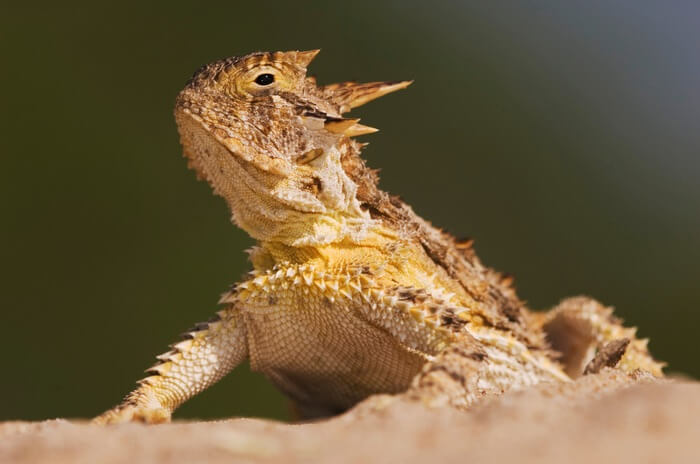
Horned lizards rely on an exclusive diet of ants to stay healthy. They use their sticky tongues to eat entire colonies of harvester ants. The special diet reportedly makes the lizard’s blood toxic, which makes it unappealing to would-be predators.
In addition to horned lizards, several species of the chameleon, anole, and gecko family of lizards eat ants whenever they can.
Snakes
Most snakes prefer to eat small mammals, fish, and giant insects. However, ants make up a big part of the regular diet for small snake species.
Take, for example, the blind snake. It’s only about the size of a quarter when coiled up. As a result, the snake can’t eat oversized food items.
Most will feed exclusively on ants and termite larvae. They also consume an impressive amount of ant larvae and eggs.
Blind snakes are found all over the globe. However, most people don’t get the chance to see them in the wild.
Thanks to their small size, blind snakes remain out of sight most of the time.
Snails
Snails are seemingly innocuous invertebrates that can inhabit gardens, bodies of water, and more.
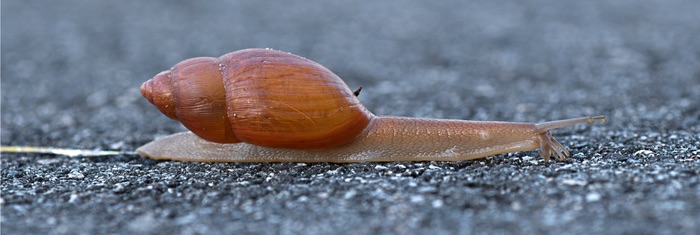
The preferred diet of these creatures varies wildly. Some stick to plants and fruits. However, some enjoy protein-based foods like ants.
Almost all carnivorous snail species will consume an ant if it happens to come by. They’ll also eat other insects like earthworms and slugs. Some common ant-eating snail species include the rosy wolfsnail and anything belonging to the Powelliphanta family.
Mammals
Several large mammal species enjoy eating ants.
The most well-known mammal to feed on these insects is the appropriately named anteater! The classic natural predator of ants, anteaters are medium-sized animals that survive on a diet that’s almost entirely ants.
There are several anteater species out there. However, they all have long snouts and tongues. The tongue is sticky enough to grab onto ants in an instant.
When they feed, anteaters will stick their entire tongue in a mound to capture as many insects as possible.
Another mammal that consumes ants is the aardvark. They look pretty similar to anteaters, but the aardvark is a little more capable of foraging for food. These animals also have sticky tongues, but they rely on their long claws to dig through insect havens.
Next, there’s the pangolin. This mammal is covered in rigid, armor-like scale plates. Despite their intimidating appearance, pangolins mostly eat ants and termites. The rugged exterior shell is merely a defense mechanism.
Pangolins also have sharp claws and a long snout. Those features help them get into hard-to-reach nests for food.
Believe it or not, some bear species will eat ants, too. Most people associate bears with predatory behaviors and carnivorous meals. However, insectivore species exist as well.
The most insectivorous bear species around is the sloth bear. Like anteaters, aardvarks, and pangolins, sloth bears have long snouts for easy ant retrieval.
Conclusion
Now that you know what eats ants, you can put this knowledge to work in your pest control efforts. While some of the insects and animals on this list won’t apply, others might be worth attracting to get rid of ants in your yard or lawn.
If you have any other bugs or animals that you think we should include, send them over!
